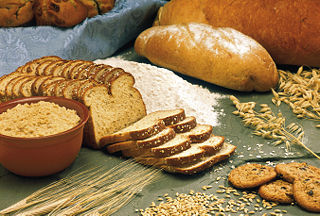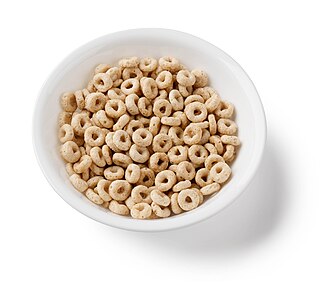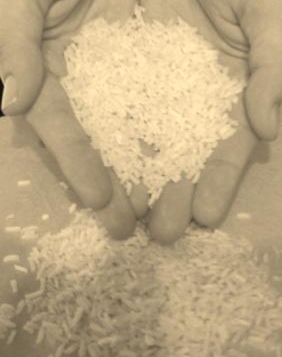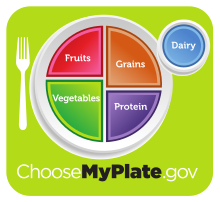
A food pyramid is a representation of the optimal number of servings to be eaten each day from each of the basic food groups. The first pyramid was published in Sweden in 1974. The 1992 pyramid introduced by the United States Department of Agriculture (USDA) was called the "Food Guide Pyramid" or "Eating Right Pyramid". It was updated in 2005 to "MyPyramid", and then it was replaced by "MyPlate" in 2011.

The Healthy Eating Pyramid is a nutrition guide developed by the Harvard School of Public Health, suggesting quantities of each food category that a human should eat each day. The healthy eating pyramid is intended to provide a more sound eating guide than the widespread food guide pyramid created by the USDA.

A healthy diet is a diet that maintains or improves overall health. A healthy diet provides the body with essential nutrition: fluid, macronutrients such as protein, micronutrients such as vitamins, and adequate fibre and food energy.
The Center for Nutrition Policy and Promotion (CNPP) is an agency in the U.S. Department of Agriculture, created on December 1, 1994, to improve the health and well-being of Americans by establishing national dietary guidelines based on the best science available. CNPP promotes dietary guidance by linking scientific research to the nutritional needs of the American public through the function of USDA's Nutrition Evidence Library, which it created and manages.

A school meal is a meal provided to students and sometimes teachers at a school, typically in the middle or beginning of the school day. Countries around the world offer various kinds of school meal programs, and altogether, these are among the world's largest social safety nets. An estimated 380 million school children around the world receive meals at their respective schools. The extent of school feeding coverage varies from country to country, and as of 2020, the aggregate coverage rate worldwide is estimated to be 27%.

A food group is a collection of foods that share similar nutritional properties or biological classifications. Lists of nutrition guides typically divide foods into food groups, and Recommended Dietary Allowance recommends daily servings of each group for a healthy diet. In the United States for instance, the USDA has described food as being in from 4 to 11 different groups.

A serving size or portion size is the amount of a food or drink that is generally served.

Food policy is the area of public policy concerning how food is produced, processed, distributed, purchased, or provided. Food policies are designed to influence the operation of the food and agriculture system balanced with ensuring human health needs. This often includes decision-making around production and processing techniques, marketing, availability, utilization, and consumption of food, in the interest of meeting or furthering social objectives. Food policy can be promulgated on any level, from local to global, and by a government agency, business, or organization. Food policymakers engage in activities such as regulation of food-related industries, establishing eligibility standards for food assistance programs for the poor, ensuring safety of the food supply, food labeling, and even the qualifications of a product to be considered organic.
The Dietary Approaches to Stop Hypertension or the DASH diet is a diet to control hypertension promoted by the U.S.-based National Heart, Lung, and Blood Institute, part of the National Institutes of Health (NIH), an agency of the United States Department of Health and Human Services. The DASH diet is rich in fruits, vegetables, whole grains, and low-fat dairy foods. It includes meat, fish, poultry, nuts, and beans, and is limited in sugar-sweetened foods and beverages, red meat, and added fats. In addition to its effect on blood pressure, it is designed to be a well-balanced approach to eating for the general public. DASH is recommended by the United States Department of Agriculture (USDA) as a healthy eating plan. The DASH diet is one of three healthy diets recommended in the 2015–20 U.S. Dietary Guidelines, which also include the Mediterranean diet and a vegetarian diet. The American Heart Association (AHA) considers the DASH diet "specific and well-documented across age, sex and ethnically diverse groups."

Vegetarian Diet Pyramid is a nutrition guide that represents a traditional healthy vegetarian diet. Variations of this traditional healthy vegetarian diet exist throughout the world, particularly in parts of North America, Europe, South America and, most notably, Asia. Given these carefully defined parameters, the phrase "Traditional Vegetarian Diet" is used here to represent the healthy traditional ovo-lacto vegetarian diets of these regions and peoples. A pyramid was created by Oldways Preservation Trust in 1998 with scientific research from Cornell and Harvard University and specific reference to the healthy patterns of eating demonstrated by the Mediterranean Diet Pyramid.

The Western pattern diet is a modern dietary pattern that is generally characterized by high intakes of pre-packaged foods, refined grains, red meat, processed meat, high-sugar drinks, candy and sweets, fried foods, industrially produced animal products, butter and other high-fat dairy products, eggs, potatoes, corn, and low intakes of fruits, vegetables, whole grains, pasture-raised animal products, fish, nuts, and seeds.
The Dietary Guidelines for Americans (DGA) provide nutritional advice for Americans who are healthy or who are at risk for chronic disease but do not currently have chronic disease. The Guidelines are published every five years by the US Department of Agriculture, together with the US Department of Health and Human Services. Notably, the most recent ninth edition for 2020–25 includes dietary guidelines for children from birth to 23 months. In addition to the Dietary Guidelines per se, there are additional tools for assessing diet and nutrition, including the Healthy Eating Index (HEI), which can be used to assess the quality of a given selection of foods in the context of the Dietary Guidelines. Also provided are additional explanations regarding customization of the Guidelines to individual eating preferences, application of the Guidelines during pregnancy and infancy, the USDA Nutrition Evidence Systematic Review, information about the Nutrition Communicators Network and the MyPlate initiative, information from the National Academies about redesigning the process by which the Dietary Guidelines for Americans are created, and information about dietary guidelines from other nations.
Fruits & Veggies – More Matters is a national public health initiative from Produce for Better Health Foundation and Centers for Disease Control and Prevention (CDC) to increase the consumption of fruits and vegetables. This campaign, begun in 2007, took the place of the 5 A Day program. The shift was implemented in order to better communicate updated dietary guidelines, which recommended more than five servings of fruits and vegetables for some Americans.

Let's Move! was a public health campaign in the United States led by former First Lady Michelle Obama. The campaign aimed to reduce childhood obesity and encourage a healthy lifestyle in children.

The Healthy, Hunger-Free Kids Act of 2010 is a federal statute signed into law by President Barack Obama on December 13, 2010. The law is part of the reauthorization of funding for child nutrition. It funded child nutrition programs and free lunch programs in schools for 5 years. In addition, the law set new nutrition standards for schools, and allocated $4.5 billion for their implementation. The new nutrition standards were a centerpiece of First Lady Michelle Obama's Let's Move! initiative to combat childhood obesity. In FY 2011, federal spending totaled $10.1 billion for the National School Lunch Program. The Healthy, Hunger-Free Kids Act allows USDA, for the first time in 30 years, opportunity to make real reforms to the school lunch and breakfast programs by improving the critical nutrition and hunger safety net for millions of children. Healthy, Hunger-Free Kids Act and Michelle Obama were a step in transforming the food pyramid recommendation, which has been around since the early 1990s, into what is now known as "MyPlate".
Nutrition education is a combination of learning experiences designed to teach individuals or groups about the principles of a balanced diet, the importance of various nutrients, how to make healthy food choices, and how both dietary and exercise habits can affect overall well-being. It includes a combination of educational strategies, accompanied by environmental supports, designed to facilitate voluntary adoption of food choices and other nutrition-related behaviors conducive to well-being. Nutrition education is delivered through multiple venues and involves activities at the individual, community, and policy levels. Nutrition Education also critically looks at issues such as food security, food literacy, and food sustainability.

MyPyramid, released by the USDA Center for Nutrition Policy and Promotion on April 19, 2005, was an update on the earlier American food guide pyramid. It was used until June 2, 2011, when the USDA's MyPlate replaced it. The icon stresses activity and moderation along with a proper mix of food groups in one's diet. As part of the MyPyramid food guidance system, consumers were asked to visit the MyPyramid website for personalized nutrition information. Significant changes from the previous food pyramid include:
The Childhood Obesity Task Force is a United States Government task force charged with reducing childhood obesity in the United States. It was founded on February 9, 2010, by the Obama Administration through a Presidential Memorandum, announcing the establishment of a Task Force on Childhood Obesity. The Task Force aims to develop a plan to reduce childhood obesity. In the announcement, President Barack Obama highlighted the statistics on childhood obesity in the United States and outlined the steps that this new task force would be taking to end childhood obesity. Section 1 of the Memorandum states:
There is established a Task Force on Childhood Obesity to develop an interagency action plan to solve the problem of obesity among our Nation's children within a generation. The Assistant to the President for Domestic Policy shall serve as Chair of the Task Force.
The history of USDA nutrition guidelines includes over 100 years of nutrition advice promulgated by the USDA. The guidelines have been updated over time, to adopt new scientific findings and new public health marketing techniques. The current guidelines are the Dietary Guidelines for Americans 2020–2025. The 2015–2020 guidelines were criticized as not accurately representing scientific information about optimal nutrition, and as being overly influenced by the agricultural industries the USDA promotes.














